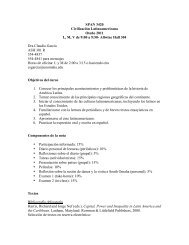It Is Broken. Can It Be Fixed? A Look at the European Union's ...
It Is Broken. Can It Be Fixed? A Look at the European Union's ...
It Is Broken. Can It Be Fixed? A Look at the European Union's ...
Create successful ePaper yourself
Turn your PDF publications into a flip-book with our unique Google optimized e-Paper software.
• As is <strong>the</strong> case with <strong>the</strong> deficit to GDP r<strong>at</strong>io, <strong>the</strong> debt to GDP r<strong>at</strong>io for France and<br />
Germany has worsened since 2001. Both countries now exceed <strong>the</strong> 60 percent<br />
reference value and continue to worsen. In addition, Portugal’s deficit to GDP<br />
r<strong>at</strong>io continues to worsen from its best year, 2000, and for <strong>the</strong> second year running<br />
is in excess of 60 percent.<br />
• The same comment concerning Greece’s d<strong>at</strong>a, as made above, is applicable here<br />
as well. Notice th<strong>at</strong> its debt to GDP percentage increased from 104.7 percent in<br />
2000 to 114.8 percent <strong>the</strong> next year, leading to <strong>the</strong> suspicion th<strong>at</strong> its d<strong>at</strong>a for 2000<br />
and earlier years was inaccur<strong>at</strong>e.<br />
• <strong>It</strong> is perhaps reasonable to conclude th<strong>at</strong> because ECOFIN’s primary focus has<br />
been on wh<strong>at</strong> to do about <strong>the</strong> deficit to GDP r<strong>at</strong>io, th<strong>at</strong> it has ignored <strong>the</strong> resulting<br />
debt to GDP r<strong>at</strong>io. In its 2002 report to <strong>the</strong> Council and <strong>the</strong> <strong>European</strong> Parliament,<br />
<strong>the</strong> Commission called for renewed <strong>at</strong>tention to <strong>the</strong> importance of debt.<br />
Only two of <strong>the</strong> newly admitted member st<strong>at</strong>es have a debt to GDP r<strong>at</strong>io in excess of <strong>the</strong><br />
60 percent reference point. Malta’s r<strong>at</strong>io is 75 percent while Cyprus’ r<strong>at</strong>io is 71.9 percent. At <strong>the</strong><br />
o<strong>the</strong>r extreme, Estonia is again <strong>the</strong> shining light. <strong>It</strong>s debt to GDP r<strong>at</strong>io is 4.9 percent, <strong>the</strong> lowest<br />
of <strong>the</strong> EU-25.<br />
Critique of <strong>the</strong> Stability and Growth Pact<br />
The original goal of <strong>the</strong> Stability and Growth Pact was to safeguard <strong>the</strong> sustainability of<br />
public finances in EMU. However, according to some experts, this goal has become less clear<br />
over time, moving towards <strong>the</strong> more ambitious goals of ensuring th<strong>at</strong> all countries follow<br />
sensible, if not optimal, fiscal policies. The Stability and Growth Pact is viewed as too intrusive<br />
and aggressive to achieve <strong>the</strong> original goal of sustainability of public finances. On <strong>the</strong> o<strong>the</strong>r<br />
10

















